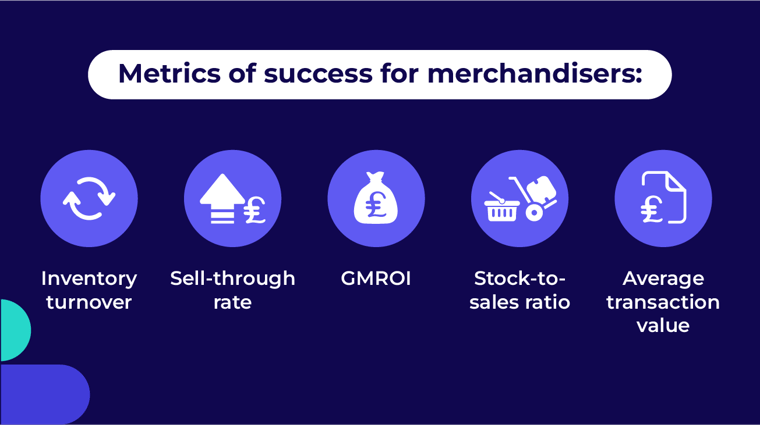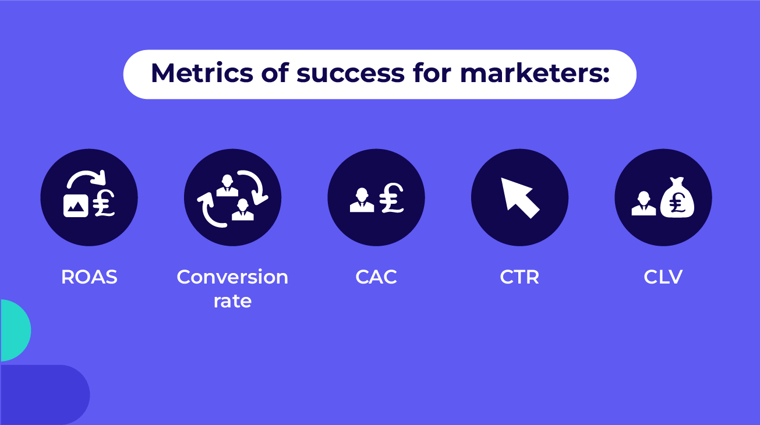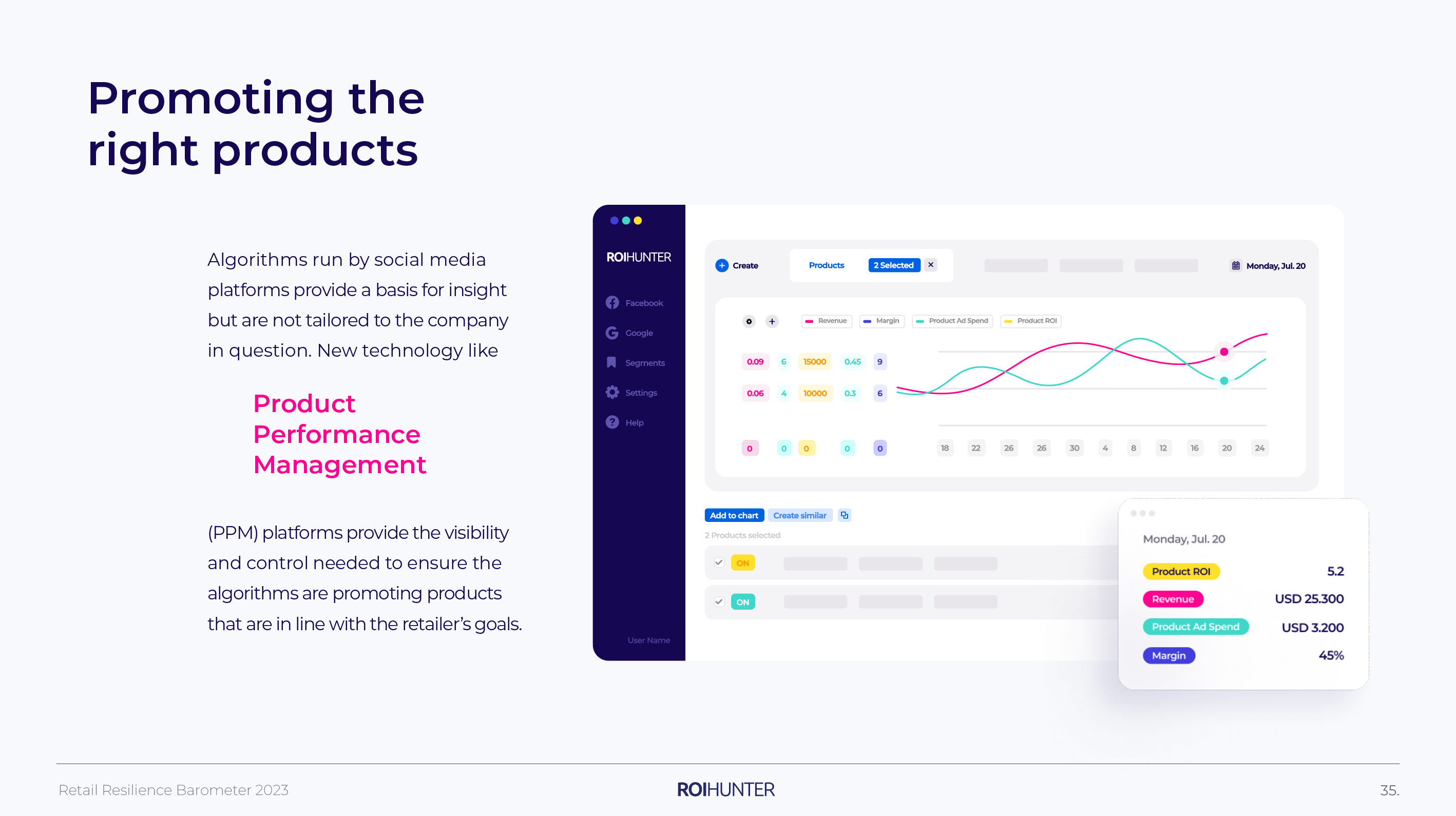In the dynamic world of retail, success is a multifaceted concept that is often measured through different lenses by different departments. The senior merchandiser, whose main focus lies in managing product assortments and optimising inventory, often finds themselves at odds with the marketing department when it comes to defining success. The disparity in the metrics used and the language spoken can create barriers to effective collaboration between the two departments.
In this article, we’ll explore the contrasting definitions of success held by merchandisers and marketers, the metrics they employ, the challenges that stem from misalignment, and practical strategies for successful collaboration.
First, we’ll give a brief overview of each departments’ metrics, but to skip ahead to solutions, click here.
First, we’ll give a brief overview of each departments’ metrics, but to skip ahead to solutions, click here.
Metrics of success for merchandisers:

Merchandisers are responsible for optimising the product assortment and inventory management to drive sales and profitability. Their main focus is on product performance and ensuring that the right products are available at the right time and in the right quantities.
Merchandisers are deeply concerned with stock keeping units (SKUs), and their key performance indicators (KPIs) often include metrics such as:
- Inventory turnover: How many times a company's inventory is sold and replaced within a specific period, usually a year. It is calculated by dividing the cost of goods sold (COGS) by the average inventory value. A high inventory turnover indicates efficient inventory management and quick product sales.
- Sell-through rate: The percentage of inventory sold over a certain period, often measured on a weekly or monthly basis. It is calculated by dividing the total units sold by the initial inventory quantity and multiplying by 100. A high sell-through rate indicates strong demand for the product and efficient merchandising.
- Gross margin return on investment (GMROI): GMROI is a profitability metric that evaluates how effectively a company uses its inventory investment to generate gross margin. It is calculated by dividing the gross margin by the average inventory cost, and the result is multiplied by 100 to express it as a percentage. A higher GMROI indicates that the inventory investment is generating good returns.
- Average transaction value: This KPI measures the average amount spent by customers per transaction. It is calculated by dividing the total sales revenue by the number of transactions during a specific period. Tracking this metric helps monitor changes in customer behaviour and can indicate the effectiveness of pricing and upselling strategies.
- Stock-to-sales ratio: This ratio compares the amount of inventory available to the actual sales made during a particular period. It is calculated by dividing the average inventory value by the total sales. A lower stock-to-sales ratio suggests efficient inventory management and timely restocking of popular products.
These KPIs provide insights into how well the merchandising strategies are driving sales, managing inventory levels, and maximising profitability.
Merchandisers also pay close attention to customer retention, as repeat business is indicative of customer satisfaction with the products offered. Customer feedback and reviews play a vital role in evaluating product performance and making informed assortment decisions.
Metrics of success for marketers:

On the other side of the retail spectrum, the marketing department's success metrics are more oriented towards brand visibility, customer acquisition, and conversion rates. Performance marketers delve into metrics such as:
- Return on ad spend (ROAS): ROAS is a key performance indicator (KPI) used to measure the effectiveness of advertising campaigns. It calculates the revenue generated from ads relative to the amount spent on those ads. ROAS is expressed as a ratio (e.g. 5:1) and indicates how much money is earned for every dollar invested in advertising. A higher ROAS suggests a more profitable campaign.
- Conversion rate: Conversion rate refers to specific actions taken by users that align with a marketer's objectives. These actions could include making a purchase, signing up for a newsletter, filling out a form, or any other desired outcome. The conversion rate is calculated as the percentage of visitors who complete the desired action out of the total number of visitors. High conversion rates indicate successful marketing strategies and efficient funnel optimisation.
- Customer Acquisition Cost (CAC): CAC is a metric used to determine the average cost of acquiring a new customer. It is calculated by dividing the total cost of marketing and sales efforts aimed at acquiring new customers by the number of customers acquired during a specific period. A lower CAC is preferable, as it indicates that customer acquisition efforts are more cost-effective and efficient.
- Click-Through Rates (CTR): CTR is a metric used in digital advertising to measure the percentage of users who click on a specific link, ad, or call-to-action (CTA) out of the total number of users who viewed it. It is commonly used to gauge the effectiveness and relevance of an ad or content. A higher CTR generally indicates that the ad is engaging and resonates with the target audience, while a low CTR may require adjustments to improve ad performance.
- Customer Lifetime Value (CLV): CLV is the total value a business can expect to generate from a single customer throughout their entire relationship with the company. It takes into account the revenue generated from the customer's purchases, the frequency of purchases, and the expected customer retention period. Calculating CLV helps businesses understand the long-term value of acquiring and retaining customers. Higher CLV signifies stronger customer loyalty and better customer relationship management. Businesses often focus on increasing CLV by providing excellent customer experiences and encouraging repeat purchases.
These KPIs allow marketers to understand how effective their advertising budgets and efforts are being used.
The marketing teams’ roles include managing campaigns, ad sets, and advertisements to attract potential customers, raise brand awareness, and drive traffic to the website or physical stores. They focus on the top of the funnel, ensuring that the right message reaches the right audience at the right time.
Why is this disparity problematic?
Language barriers
The language employed by merchandisers and marketers can sometimes be a barrier to understanding and collaboration. While merchandisers discuss SKUs, brand performance, and category management, marketers speak in terms of ads, ad sets, and campaigns. This divergence in terminology can lead to confusion and misunderstandings, hindering effective cross-functional communication.
Shifting roles

Historically, when the focus was on physical stores, the marketing department was mainly responsible for bringing traffic to the shop while the merchandising department was in charge of store layout, which products were displayed, and making sure the stock was sold in the optimal way for the optimal price.
Then consumer shopping moved online. This meant marketers became responsible for bringing traffic to the online store while the merchandisers’ role shifted to owning the website, manipulating product rank, creating banners, promoting recommended products, and so on.
Now consumer behaviour has shifted yet again- this time to mobile devices. Because the screen is so small, shoppers browse the store website far less than before. Discovery happens directly from Facebook Carousel and Google Shopping, rather than through the desktop version of the website.
Misaligned priorities
With the merchandising and marketing departments’ priorities misaligned, challenges arise. While both teams do focus on revenue, they focus on different components of quality of revenue. Merchandising looks at revenue vs. margin of product while marketing focuses on revenue vs. ad spend (ROAS).
In addition, merchandisers don’t know ad cost for certain products so they disregard it in unit economics. Marketers know the ad cost but don't know the COGS or the margin of a certain product. Both parties have limited visibility because particular data is owned by the other party, making it extremely difficult to align.
What happens with misalignment is that the merchandiser is trying to make sure new arrival products are prioritised for promotion, because they know it’s going to be sold at full price. They don’t want to pay the costs associated with storing new products at the warehouse, so they optimise efforts toward new arrivals being visible.
Meanwhile, marketing doesn’t care about margin or warehouse costs. Their main concern is to create the easiest possible conversions, so they prioritise promoting discounted products, which jeopardises the margin and increases the length of stock turnover.
The main problem is each team prioritises completely different products.
Part of the challenge stems from removing the ability to own the user journey from merchandisers, as it now starts in Facebook Carousel or Google Shopping. It creates a problem, because the marketing department decides what is being sold, leaving merchandisers with limited power and influence, and resulting in excess inventory and suboptimal margins for the retailer.
In order to improve profitability, merchandising and marketing departments need to align, in real time.
Creating successful collaboration
To foster a harmonious relationship between merchandisers and marketers, both parties need to bridge the gap by acknowledging and understanding each other's metrics and language. Here are some strategies to facilitate successful collaboration:
Shared Goals and KPIs: Aligning overarching goals and key performance indicators can be the foundation for a unified approach. When merchandisers and marketers have shared objectives, their efforts become synergistic, leading to improved results for the business as a whole.
Data Sharing and Transparency: Open communication and sharing of data between the departments is crucial. Merchandisers can provide valuable insights into product performance, which can help marketers in crafting more effective campaigns. Marketers can share customer insights and trends to aid merchandisers in making data-driven assortment decisions. Alignment can be achieved in real time through solutions such as a product performance management (PPM) platform.

Cross-Functional Meetings: Regular cross-functional meetings can foster collaboration and allow both departments to share updates, insights, and challenges. These meetings provide a platform for discussing joint strategies, addressing conflicts, and brainstorming new ideas.
Continuous Learning and Training: Both departments should be encouraged to participate in workshops and training sessions to gain a better understanding of each other's roles and responsibilities. This can help break down silos and promote a more integrated approach.
Final takeaway
The success of a retail business relies on a harmonious collaboration between its merchandising and marketing departments. The differing definitions of success, metrics, and language used by these two teams can create barriers that hinder effective communication and alignment.
By establishing shared goals and key performance indicators, and fostering data sharing and transparency, these teams can work together towards a unified approach that benefits the business as a whole. Utilising real-time solutions, such as a product performance management (PPM) platform, can facilitate alignment and enable both teams to make data-driven decisions.
By working towards a shared vision, retailers can optimise their efforts, enhance profitability, and achieve sustainable success in a competitive marketplace.
For further reading about how to align merchandising and marketing teams, check out our e-book



.png)
